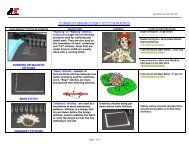Compiled Embroidery Skill Articles
You also want an ePaper? Increase the reach of your titles
YUMPU automatically turns print PDFs into web optimized ePapers that Google loves.
10/28/2016 Hat Tricks<br />
product for their customers.<br />
<strong>Embroidery</strong> is a representation of art and not an exact duplication of it. The biggest<br />
mistake you can avoid in headwear embroidery production is accepting a project<br />
that presents clarity issues in the design and letters. Prior to taking an order ,<br />
discuss the adjustments that need to be made for quality results.<br />
There are some important overall guidelines to observe when embroidering on<br />
hats:<br />
1. Minimum letter size should be 1∕5inch tall.<br />
Process Engineering<br />
When Michael Rothermund got laid of f from his<br />
fourth job in the engineering industry , he knew it<br />
was time for a change — and all signs pointed to<br />
the Tshirt business...<br />
Read more<br />
2. Most customers are not satisfied with the look of lettering done with a running<br />
stitch.<br />
3. Lettering with serif fonts and some thin sans serif fonts need to be increased<br />
so their lines are thick enough.<br />
4. The type of hat dictates the embroidery size.<br />
5. Some small elements, such as lettering or thin lines, need to be removed or<br />
enlarged.<br />
6. A logo that may work on a baseball cap may need to be modified to work on a<br />
visor or bucket hat.<br />
7. Hoop burn is an issue common to all hat styles, so spray water on the location<br />
and lightly brush the fabric.<br />
Following are some common issues for each headwear style and their solutions,<br />
which will help you avoid costly mistakes, better service your existing embroidery<br />
clients and increase your revenue per client.<br />
Beanies/T oques<br />
This headwear type enables embroidery on all four sides. However , common<br />
elements like stripes or other designs may interfere.<br />
Solution: Find a location that works for the size of the design. Beanies and toques<br />
often are made of fleece or knitted fabrics, so pay attention to small elements that<br />
could disappear in the soft fabric. There must be suf ficient underlay to ensure the<br />
top stitching has a stable surface to stitch into.<br />
One option is to use a solid fill stitch so you can embroider over the stitches, giving<br />
you a surface that will not bury .<br />
As a last resort, Solvy is a watersoluble embroidery topping best used on knits,<br />
terry cloth, fleece and other textured fabrics to create a smooth surface. However , it<br />
should only be used as a last resort.<br />
Bucket Hats<br />
<strong>Embroidery</strong> size varies by bucket hat style. Some can fit the full 2½inchtall height<br />
and others allow less than an inch due to the hat’ s construction. Most bucket styles<br />
have a fabric band around the bottom of the crown restricting the available design<br />
space, as you can not embroider over the band.<br />
Bucket hats also commonly have air holes, eyelets and snaps on the side that get<br />
in the way of embroidery. During production, bucket hats with larger brims can get<br />
grease on them from the embroidery machine.<br />
Solution: Given the space restrictions for this type of hat, it may be best to strictly<br />
stick to the front or back for design placement. Also, keeping your machine clean is<br />
the best line of defense against grease stains. Always wipe the machine clean after<br />
oiling it. Although time consuming, this is a necessary step, especially when working<br />
http://impressions.issshows.com/embroiderydigitizing/HatT ricks9833.shtml 2/4




